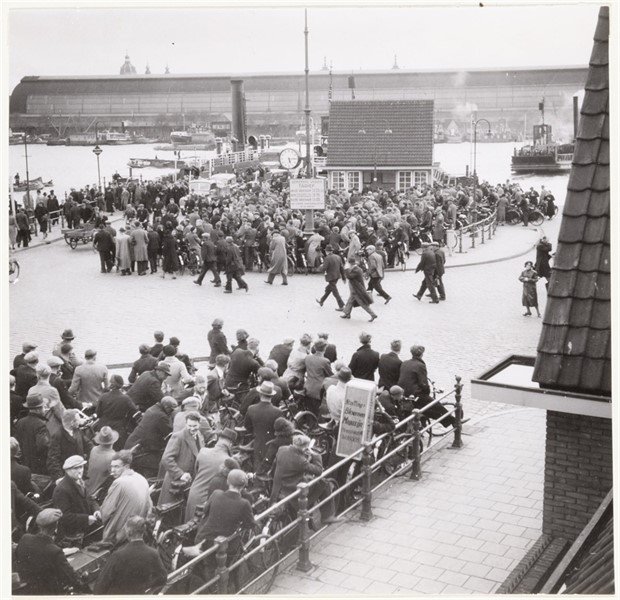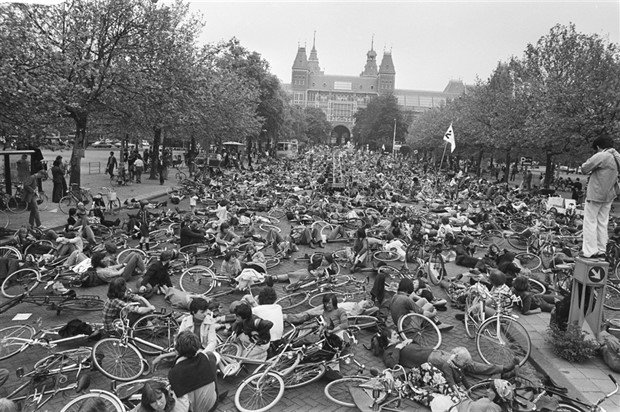Triumph of the Amsterdam cyclist?
The United Nations has declared June 3 as World Bicycle Day. In terms of bicycle use, Amsterdam is ahead of many foreign cities, and has a considerable exemplary role. Nevertheless, the introduction of the bicycle did not go smoothly here. And the arrival of the car didn’t make it any easier
New: the Amsterdam cyclist
In 1868 the first bicycles could already be seen in Amsterdam. ‘Sometimes one sees three or four cyclists at the same time in the Leidschestraat’, writes a newspaper. Cycling clubs were set up here and there. The bike was initially expensive and exclusive. After that, its popularity increased rapidly. As early as 1930, one-third of traffic consisted of cyclists. Pedestrians also formed a third, and public transport a quarter. Only 5% of the traffic consisted of cars. But that changed: the 20th century would be the century of the car.
Rise of the car
The rise of the car is considered a natural phenomenon. The government welcomed the ‘general motorization’. The city council also wanted to make traffic completely subordinate to the car. In traffic, the law of the strongest applied. Cycling became ‘playing with your life’. In the last century, Amsterdam seemed to be taking the same path as other European cities that gave way to the car.
Extreme car minded country
Around 1930 there were 7,000 cars in Amsterdam and 68,000 cars throughout the Netherlands. That changed quickly, much faster than expected. The Netherlands now has more than 8 million cars. It’s a car country like any other, even an extreme car country measured by the number of cars per square kilometer. For the past 70 years, a battle took place in the city between the car and the bicycle. In the 60’s it seemed that the car would wipe out the bicycle, and Amsterdam would become a car city. But that didn’t happen in the end.

| Buiksloterweg, waiting for the ferry connection, around 1950. Photo: Stadsarchief Amsterdam
No bicycle in future visions
At first, Amsterdam almost accidentally became a cycling city. Due to the clear dimensions and the flatness, the city dwellers started cycling en masse. The bicycle spontaneously became the main means of transport in the city, without much government control. But in the 50s and 60s, more and more cars were coming into the city, and policymakers and traffic engineers saw cycling as a declining business. They ignored the bike in their future visions as if it no longer existed. It seemed Amsterdam would become a large-scale, and modern city where living and working would be connected by urban highways. But it turned out differently.
114 fatalities
Cars dominated the city and bicyclists were in great danger. The number of road accidents increased, with a nadir of 114 deaths in 1970. Nowadays, there are around 15 deaths per year. An influential pressure group in the Netherlands in the 70s, called ‘Stop de Kindermoord’ (‘Stop child murder’), protested against the horrific insecurity in traffic and the apathy and fatalism of the authorities and the population. The initiative also had a lot of resonance in Amsterdam.

| National demonstration on the Museumplein against road safety, 1977. Photo: Stadsarchief Amsterdam
Compact city
Decisive for the future of traffic is the overarching new vision of the city since that time. Amsterdam became a ‘compact city’, and not an expanding city connected by major roads. After a long-term conflict between the ‘large-scale’ and the ‘small-scale’, the proponents of the ‘human dimension’ won. Amsterdam remained ‘compact’, and therefore the bicycle remained a practical means of transport. Since 1978, the municipality has strived to improve the cycling climate.
Car restricted
The car was, among other things, restricted with a stricter parking policy, speed bumps, and one-way traffic. Separate bicycle paths and a ‘main network bicycle’ were built. With great difficulty the streets were decorated to give everyone space. The Amsterdam Cyclists’ Union, founded in 1976, played (and still plays) a major role in representing the interests of cyclists.
One of the best cycling cities in the world
Amsterdam and Copenhagen are now seen as the best cycling cities in the world. In these cities, there is a balance between the car and the bike, where the bike is very useful. Of course, it’s never perfect. In Amsterdam, for example, 6% of cyclists are ‘reckless cyclists’ who have a grind on everything. Some don’t think that’s much, but that makes about 25,000 cyclists a day that put others in danger – this number remains a lot. The most recent major change in traffic is that moped riders must wear a helmet and get off the bike path. That measure took effect on 8 April 2019. A new milestone in the perpetual battle for public space.







